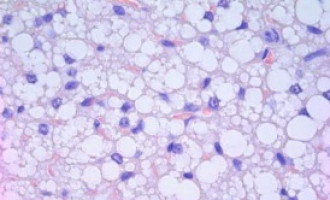
Glioblastoma is a lethal form of brain cancer that accumulates fats in lipid droplets and uses them as energy for rapid cell division.
Blocking an enzyme that GBM cells use to form the lipid droplets might offer a new way to treat this deadly disease, according to a new study led by researchers at The Ohio State University Comprehensive Cancer Center - Arthur G. James Cancer Hospital and Richard J. Solove Research Institute (OSUCCC - James).
GBM has an average survival of 12-15 months after diagnosis, a period that has remained unchanged for two decades.
New, more effective treatments are desperately needed.
In earlier work, this same research team learned that GBM cells accumulate unusually high levels of fatty acids and use them as a source of energy needed for rapid cell growth.
Normally, excessive levels of fatty acids are deadly to cells.
In this study, published in the journal Cell Metabolism, the researchers looked at an enzyme called DGAT1 (diacylglycerol-acyltransferase 1).
GBM cells use the enzyme to package fatty acids into lipid droplets.
The enzyme converts fatty acids into molecules called triglycerides, which can be safely stored as lipid droplets in the cancer cells' cytoplasm.
Blocking DGAT1 diverted the excessive fatty-acid molecules to mitochondria, the cells' energy-producing organelles, rather than to storage.
This overwhelmed the organelles, causing them to produce high levels of destructive molecules called oxygen radicals (also called reactive oxygen species).
This, in turn, damaged the mitochondria and triggered the cells to self-destruct through a process called apoptosis.
"These findings suggest that inhibiting DGAT1 might offer a new therapeutic approach for the treatment of glioblastoma," says principal investigator Deliang Guo, PhD, professor of Radiation Oncology and director of Center for Cancer Metabolism at Ohio State.
"This same approach might also apply to cancers such as prostate, colon, renal and others, which also show lipid-droplet formation," says Guo, who is a member of the OSUCCC - James Translational Therapeutics Program.
For this study, Guo and his colleagues analysed patient tumour tissue, multiple GBM cell lines and an animal model to examine fatty acid metabolism and lipid droplet formation in GBM.
Key findings of the study include:
Two enzymes, DGAT1 and DGAT2, are involved in the storage of triglycerides and the formation of lipid droplets, but DGAT1 is the dominant enzyme.
Inhibiting DGAT1 suppressed triglyceride and lipid droplet formation, leading to high levels of fatty acid oxidation in mitochondria, severe oxidative stress and GBM cell death.
In xenograft models, inhibiting DGAT1 suppressed GBM growth without noticeable toxic side effects.
"Overall, our findings may lead to the identification of lipid-metabolism pathways that are unique to glioblastoma and other malignancies, and to new therapies for these cancers," Guo says.
We are an independent charity and are not backed by a large company or society. We raise every penny ourselves to improve the standards of cancer care through education. You can help us continue our work to address inequalities in cancer care by making a donation.
Any donation, however small, contributes directly towards the costs of creating and sharing free oncology education.
Together we can get better outcomes for patients by tackling global inequalities in access to the results of cancer research.
Thank you for your support.